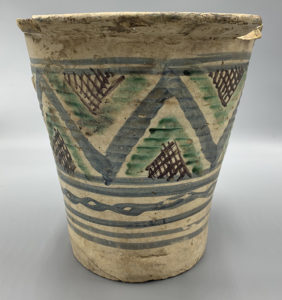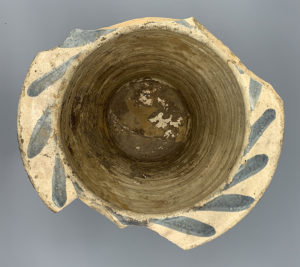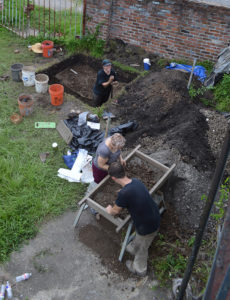A Chamber Pot in New Orleans: Spanish Majolica and the Early Creole City
EMERGING SCHOLARS > SUMMER RESEARCH GRANTS
by Christopher Grant
New Orleans is often touted as a city with a rich and storied past, but a deep and romantic fascination with the city’s French origins have left other eras understudied. In recent years, scholars have worked to rewrite the city’s colonial narrative, but popular historical tropes remain intractable.
The period of Spanish rule, for example, which began in 1763, is often overlooked as a force in fostering the development of the city’s unique Creole population and culture. While the Spanish regime maintained a decisive role in matters of colonial growth and governance, the era is perhaps even less understood for its contributions to the everyday material culture of early Louisiana.
Archaeology maintains a distinct advantage in making new discoveries about the material past. Typical archaeological assemblages, replete with numerous broken pottery sherds and bottle glass, are pieced together to develop alternative perspectives that privilege the mundane activities that constitute everyday life. Ceramics are an important part of this story, as they are among the objects people use in constructing culture groups and reinforcing social identities.
While the Spanish made significant contributions to the architectural and culinary traditions of New Orleans, their influence on the use of everyday objects like ceramics has been less clear. Archaeologists have generally accepted the low occurrence of Spanish pottery on historic sites in New Orleans as evidence of the empire’s limited economic and cultural reach. New archaeological excavations in the city are challenging that perspective.
Excavations at the site of the former Tremé plantation (1780s–1810) are turning up rare and notable artifacts from the city’s Spanish past. Although archaeologists typically determine the proportion of a ceramic type within an assemblage as an indication of its relative importance at a site, the size and quality of an individual pot may also be a reflection of social or cultural value. Unlike the small sherds that are common on historic sites, intact vessels command a presence that provokes thought and admiration among archaeologists and material culture enthusiasts alike. One such artifact from the Tremé plantation is a blue-green bacín, a nearly complete example of the majolica vessel type affectionately known as the “Spanish chamber pot” (figures 1 and 2).
Bacíns are unlike other chamber pots in their distinct form and shape. The Tremé example exhibits typical characteristics of the type, including a cream-colored paste and an off-white tin enamel decorated in geometric designs of dull blue, green, and black paint. The bacín measures approximately 24 cm in height, with a top diameter of 26 cm, and features a ridged interior and smoothed exterior surface.
Dated to after 1750, blue-green bacíns are believed to have been made in Spain. Their presence has been noted in deposits of the Second Spanish Period (1784–1821) with a distribution range that stretches from Florida to Central America and the Spanish Caribbean (figure 3). Although blue-green bacíns have been noted previously on New Orleans sites, their appearance is rare.1
The unexpected presence of the blue-green bacíns in the Tremé assemblage demands special attention given the predominant pottery styles of the time. By the end of the 18th century, refined earthenwares were in high demand, met in large part by the British ceramic industry that flooded markets across the Atlantic. In the 1760s, the popularity of British ceramics soared, so much so that creamware vessels are the defining material signature of Spanish-era archaeological deposits in New Orleans.
Tin-enameled earthenware pottery—largely comprised of French-made faience—continues to appear in archaeological contexts throughout the 19th century, fueled by local desires for French goods and wares. But any local demand for Spanish majolicas has been considered inconsequential.
In addition to the intact bacín, three additional large sherds, representing a total minimum number of three vessels, were also uncovered at the Tremé plantation site (figure 4). Why then does the Spanish chamber pot appear so notably here when it is largely absent from other sites? One clue to the significance of the type may come from the archaeological deposits that are unique to the plantation site itself. The Tremé bacín was uncovered in an unusual deposit of refuse associated with the enslaved laborers living on the plantation. Found alongside the debris of everyday economic activities, ranging from button making to cattle butchery, the bacín fragments come from a set of Spanish vessels that were in everyday use but kept out of sight.
Although the bacín is a unique discovery, a number of Spanish vessels uncovered archaeologically provide new insight while raising fresh questions about the role of ceramics in Spanish New Orleans. The discovery of tin-enameled Spanish Hispanic earthenwares alongside other utilitarian vessels confirms the well-known but materially unsubstantiated trade networks that tied New Orleans to other important ports in the Spanish Atlantic. In this way, the materiality of the Tremé bacín is a tangible testament to the Spanish presence in the early creole city.
The appearance of these vessels on the plantation also generates significant questions about the specific values attributed to Spanish pottery. Did the rustic character of Spanish utilitarian wares deem them more appropriate for use by enslaved laborers than for elite members of the household? Or did their designation as “utilitarian” wares supercede their capacity for aesthetic value? While the distinctive appearance of Spanish chamber pots was likely as striking in the past as it is today, they are limited in their ability to speak to the tastes and preferences for ceramics at the end of the 18th century. Rather, the close and intimate association between these pots and the city’s enslaved residents may ultimately provide a rare opportunity for examining the everyday aesthetics of early urban slavery. As a result, we may learn if and how Spanish vessels serve as an index of the unique and intimate material worlds of the city’s enslaved population.
As archaeologists are granted greater access to new contexts such as the Tremé plantation site, we may develop a more comprehensive understanding of the variable meanings and uses assigned to Spanish pottery in the early creole city.
1 For an extended discussion of the presence of majolica vessels on New Orleans archaeological sites, see Jill-Karen Yakubik, “Ceramic use in late eighteenth century and early nineteenth century southeastern Louisiana” (PhD diss., Tulane University, 1990).
Christopher Grant is a Doctoral Candidate, Department of Anthropology, University of Chicago and a 2019 Summer Research Grant recipient.
A print version of this article was published in The Magazine of the Decorative Arts Trust, one of our most popular member benefits. Join today!




